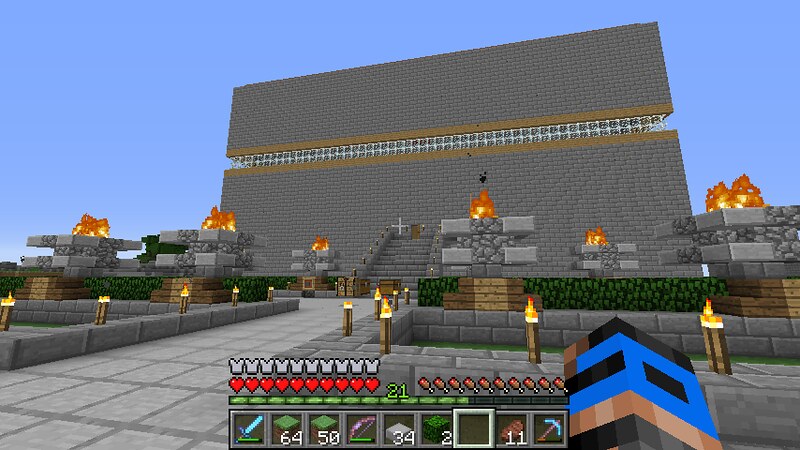Project X’s Atlantis
Video Games And/As Theory, 2014
Christian Leroux, Laura Susel, Alyssa Boicel, Kimberley Giroux, Andrew Brooks, Brian MacKenzie, Diane-Nicole Macapuno, Michele Muchandani, Sarah Hamad, Zachary Fisher

Beginning from Barbara Goodwin’s distinction between a critical and a constructive utopia (124), and with Plato’s dialogues Critias and Timaeus, along with Ursula K. Le Guin’s novel Left Hand of Darkness as their guides, the members of Project X proposed to construct an Atlantis in the sky that would house, in their words, “a more powerful, sustainable, and united society on the foundation of virtue and peace between all citizens and players.”
The buildings on the site are a combination of Plato’s description and the team’s sense of the sorts of buildings that the population would have required — Agora, Ecclesiasterion, ampitheatre, gymnasium, baths and so on. The floor plans were close copies of classical Greek architecture, with the exception of the central palace, which is modeled on the Haga Sophia. In all cases, scale is approximately 25%, which still produced a floating city 150 blocks in the air, with a 390 block circumference, where a block is approximately 1 meter. It took the team half the semester to simply lay the project’s foundation.
The team had a major advantage in that one member was already working professionally on commercial Minecraft servers, building structures for their players. By March 3, this student had shifted over 110,000 dirt blocks for this project and was producing another 100,000 blocks of quartz for the buildings. He logged hundreds of hours, designed systems and wrote tutorials for the other players, made instructional videos explaining the machines he had constructed, helped build railways and portals to connect Project X to the other teams in the class, assisted the other teams with their own designs, and so on to the point where the other students started to refer to him as “Minecraft Jesus” and erected a temple in his honour.

The logistics of project management immediately immersed the students in the thornier problems of governmentality. Though the final version of Atlantis was extremely impressive, several group members became profoundly disenchanted with the menial tasks they had been assigned by their classmates in order to complete it. The group quickly devolved into a two-tier class structure within the “builders” (the most experienced and most active student game players) on top and the students who were less experienced players as subalterns. This hierarchy was implicit in the ground plans of the floating city itself, which, in the words of its builders, had a large outer ring for the poor, a middle zone for the middle class, and a centre area for “the elite.”

Moreover, as team member Laura Susel describes in “Atlantis Transcends,” her postmortem on the project for the TAG website, the process of resource-gathering stripped the neighbouring landscape bare. Worse, the vast bulk of Atlantis blocked all sunlight from the world’s surface. In Minecraft, that is a Very Bad Thing, as it allows “mobs” (monsters) to breed, making the recovery of assets dropped by players who had fallen off the structure to their death particularly difficult.

The pressing need for materials led to the only real exploit in the game at the time: the construction of a block duplication machine in the Nether. The white blocks that comprise the majority of Atlantis’s structures can only be constructed out of crystals found in the Nether, which then have to be combined in groups of 9 to form a block — a dangerous and laborious process.

As a workaround, group members found a number of YouTube videos describing a common exploit which inadvertently duplicates blocks in Minecraft machines called “Hoppers.” When two Hoppers are connected to each other across the “chunks” of the virtual world, items and blocks placed inside them sometimes duplicate as the chunks reload when players or items enter them. After weeks where team members spent hours moving their avatars in and out of a Nether portal to activate the duplicator, they managed to automate and massively upscale this process, creating a flood of quartz and lapis lazuli blocks, enchanted diamond armour and tools and other goodies for the project X team, allowing Atlantis to be constructed from some of the most rare substances in the game.
This is another point where ethics enter the picture — not because of the exploit itself, as Minecraft proper has no rules or instructions. However, the intense concentration of game assets in Atlantis, and the continual loading and unloading of chunks by the block duplicator, affected other students’ attempts to finish their own projects by slowing gameplay in the world to a crawl. Project X’s Atlantis was perfect but uninhabitable, constructed at considerable cost to themselves as a team, to the neighbouring virtual environment, and to the ability of their classmates to complete their own assignments.
A PDF copy of the group’s project proposal
A PDF of a selection of screenshots compiled by the group
Blog post by group member Laura Susel
A WordPress site created by the group



